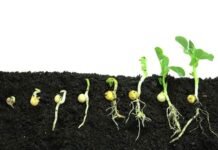The global agricultural lubricants market size reached US$ 3.4 billion in 2022. The market is poised to hold revenues worth US$ 3.6 billion in 2023. In the assessment period 2023 to 2033, revenue is expected to propel at 5.7% CAGR. This is projected to result in a market sum of US$ 6.3 billion by the end of 2033.
The rising adoption of advanced machinery and equipment in agriculture, such as tractors, harvesters, and irrigation systems is a key factor driving demand in this market. The high demand for lubricants results from the need to ensure smooth operation and maintenance of equipment.
Modernization and mechanization has allowed for large-scale and more efficient agricultural operations. This has resulted in increased demand for lubricants to keep the machinery running smoothly and minimize downtime.
The diverse range of agricultural machinery requires specialized lubricants to meet the specific needs of diverse components. It promotes the development and sale of a wide variety of lubricant products. Proper lubrication helps extend the lifespan of farming equipment, reducing the need for frequent replacements. It will further drive demand for lubricants as farmers aimed to protect their investments.
Modern farming practices, such as precision agriculture, rely heavily on accurate machinery performance. This results in a high requirement for lubricants to maintain the precision and efficiency of high-tech farming equipment. Growing environmental awareness and regulations have prompted the development of eco-friendly lubricants for agricultural machinery. It has created a new market segment within the agriculture lubricants industry.
Mechanization and modernization have played a crucial role in meeting the growing global demand for food. As agricultural productivity increased, the demand for lubricants to support the machinery driving this productivity also rose. Advancements in lubricant technology, such as synthetic lubricants and additives, further contributed to the demand. It offers enhanced performance, long intervals between lubricant changes, and improved machinery efficiency.
Mechanization and modernization efforts are rampant in emerging markets, as they transition to more efficient farming practices. This is expected to lead to increased adoption of agricultural machinery and subsequently drive demand for lubricants.
Modern farming operations require reliable machinery performance, making maintenance crucial. Lubricants play a vital role in preventing breakdowns and ensuring consistent equipment operation, further fueling demand.
The shift towards more sustainable and eco-friendly agricultural practices drives the demand for bio-based and organic lubricants that minimize soil and water pollution. Sustainable farming practices emphasize the use of eco-friendly machinery, which often require specialized lubricants that are biodegradable and non-toxic.
Sustainable farming relies on precision agriculture techniques, leading to increased usage of machinery requiring efficient lubrication for optimal performance. Growing demand for organic farming necessitates lubricants that align with organic certification requirements, boosting the need for specialized products.
Sustainable practices aim to minimize environmental impact, prompting farmers to choose lubricants that are environmentally friendly and reduce soil and water contamination. Sustainable farming encourages crop diversification, leading to a wider range of equipment needing lubrication for farming activities.
Sustainable practices prioritize energy-efficient machinery, which relies on high-performance lubricants to reduce friction and energy consumption. Regulations promoting sustainable farming may require the use of specific lubricants that adhere to environmental and safety standards.
Sustainable farming practices focus on prolonging the lifespan of equipment, driving demand for lubricants that enhance equipment durability and reliability. As consumers become more conscious of sustainability, farmers might opt for lubricants that align with their customers’ values. The demand for sustainable farming has spurred research and development of advanced lubricant technologies tailored to the agriculture sector.
2018 to 2022 Agricultural Lubricants Sales Analysis Compared to Demand Forecast from 2023 to 2033
The global agricultural lubricants market is poised to expand at 5.7% CAGR over the forecast period. During the historical period between 2018 and 2022, sales had escalated at 6.9% CAGR. In 2022, the revenues from the agricultural lubricants industry stood at US$ 3.4 billion.
Increasing mechanization and modernization of agriculture in developing countries were contributing to the rising demand for agricultural lubricants. Evolving regulations related to emissions, safety, and environmental standards have influenced the formulation and use of lubricants in the agricultural sector.
The adoption of e-commerce and digital platforms for purchasing agricultural lubricants was simplifying the procurement process for farmers and equipment operators. Governments and regulatory bodies are imposing stricter environmental regulations, pushing the industry to use lubricants that are less harmful to the environment.
Farmers and agricultural workers are recognizing the importance of regular equipment maintenance. This is likely to lead to an increased demand for lubricants to prolong machinery lifespan and reduce downtime. The adoption of precision farming techniques, which rely on GPS and sensor technology, necessitate well-lubricated equipment for accurate and efficient operations.
As emerging economies continue to develop, their agricultural sectors expand, contributing to higher demand for lubricants to support increased farming activities. Ongoing research and development efforts result in lubricants that offer better performance, long service intervals, and improved machinery efficiency, driving market growth.
The growth of online sales platforms facilitates easy access to lubricants, expanding the market’s reach and convenience for buyers. Collaborations between lubricant manufacturers, machinery producers, and agricultural associations to raise awareness about the benefits of proper lubrication have further driven demand.
Creation of Advanced Lubricants Bring the United States into Limelight
The United States agricultural lubricants market is set to hold a total of around US$ 1.3 billion by 2033. It is predicted to expand at 5.7% CAGR during the forecast period 2023 to 2033.
The United States manufacturers are investing heavily in research and development activities. This has led to the creation of advanced lubricants that are helping enhancing the efficiency of machinery. The well-developed supply chain network in the United States ensures that the lubricants are easily and timely available.
The United States has a massive agriculture sector that provides great opportunities for growth in this market. Companies are aiming to manufacture eco-friendly lubricants that are aligned with specific trends and policies.
Stringent quality and safety requirements guarantee that agricultural lubricants in the United States satisfy high industry standards, improving their reputation and appeal. The existence of world-class agricultural research institutes encourages innovation and cooperation, which leads to the creation of cutting-edge lubricating solutions.
Integration of IoT and Precision Agriculture Drives Demand in China
China agricultural lubricants industry is poised to exhibit a CAGR of 5.6% during the assessment period. By 2033, China is expected to reach US$ 1.3 billion.
China’s massive agricultural sector allows for large-scale production of lubricants, leading to economies of scale and competitive pricing. China’s access to key resources such as minerals and chemicals used in lubricant production gives it a strategic advantage.
As per the Food and Agriculture Organization, China is capable of supplying food for one fifth of the world’s people and produce a fourth of the world’s grains with only ten percent of the global agricultural land. China leads the world in grains, textiles, vegetables, fruits, poultry, eggs, meat, and fisheries goods output.
China’s focus on research and development enhances product innovation and formulation. This is expected to lead to improved lubricant performance tailored to agricultural needs. With its strong manufacturing base, China can produce agricultural lubricants at low costs. This makes them attractive for export to other markets.
Integration of technology such as IoT and precision agriculture in China’s farming practices increases the demand for specialized lubricants, boosting the domestic market. Favorable policies and incentives from the Chinese government can further stimulate the growth of the agricultural lubricants industry.
Mineral Oil Lubricants Driving Growth due to being Highly Cost-effective
By type, the mineral oil lubricants segment is set to be at the forefront of the global market during the assessment period. From 2023 to 2033, sales are poised to expand at 5.6% CAGR. Mineral oil lubricants tend to be more cost-effective to produce, making them an attractive option for price-conscious agricultural businesses.
Mineral oil lubricants are widely available and accessible, ensuring a steady supply for the agricultural sector. They are compatible with a broad range of agricultural machinery, reducing the need for specialized lubricants.
Mineral oil lubricants have a history of reliable performance in different applications, building trust among farmers and manufacturers. Familiarity with mineral oil lubricants from other sectors may encourage easy adoption for agriculture.
Using a single type of lubricant (mineral oil) across different equipment simplifies inventory management. Mineral oil lubricants have a global presence, enabling expansion into various geographic markets. Effective education and outreach about the benefits and applications of mineral oil lubricants can drive market dominance.
Demand from Engines Division to Boost Growth by Reducing Equipment Downtime
The engines segment is expected to register a 5.5% CAGR from 2023 to 2033. The target segment is likely to take center stage in the global agricultural lubricants market. Engine segments offer specialized lubricants tailored to the specific needs of agricultural machinery. It will result in optimized performance, reduced wear, and prolonged engine life.
Engine segments cover a wide range of agricultural equipment, including tractors, harvesters, and sprayers. It ensures comprehensive lubrication solutions for diverse farming operations.
Continuous research and development in engine segment lubricants has led to innovative formulations. These novel formulations can withstand high temperatures, heavy loads, and harsh conditions commonly encountered in agriculture.
Engine lubricants are increasingly formulated to be eco-friendly, meeting stringent regulations while minimizing ecological impact. This is also expected to appeal to sustainability-conscious farmers. High-quality engine lubricants contribute to extended maintenance intervals, reducing downtime and maintenance costs for farmers and agricultural businesses.
Engine lubricant providers often offer training and technical support to farmers. This is facilitated to help them understand the importance of proper lubrication and its impact on machinery performance and longevity.
Competitive Landscape
Key manufacturers are expanding their product portfolios to offer a wide range of lubricants tailored for different agricultural machinery and equipment. They are developing eco-friendly and biodegradable lubricants to align with sustainable farming practices.
Manufacturers are incorporating IoT and sensor technologies to provide real-time monitoring of lubricant performance and machinery condition.
For instance,
In August 2022, Evonik’s Oil Additives business line has revamped its distribution arrangement in CIS nations, naming ADCO as its brand-new distribution partner.
In October 2022, Valvoline Cummins Private Ltd. has introduced the Valvoline All Fleet Turbo Plus an industry-exclusive product. This is for heavy road use of high horsepower tractors and other agricultural linked tasks.
These insights are based on a report on Agricultural Lubricants Market by Future Market Insights








